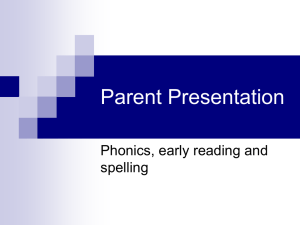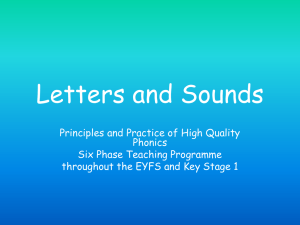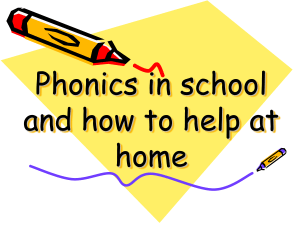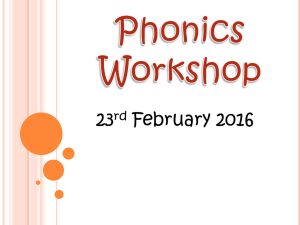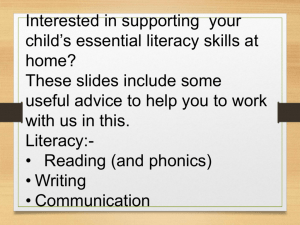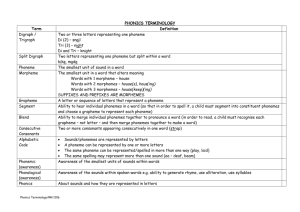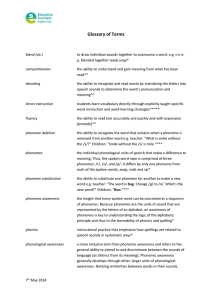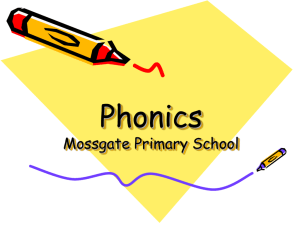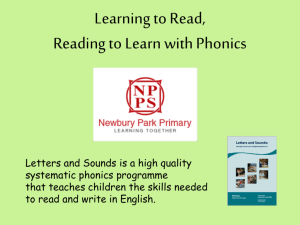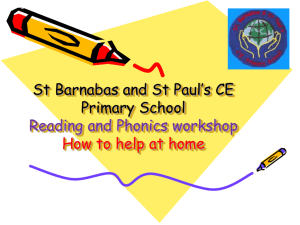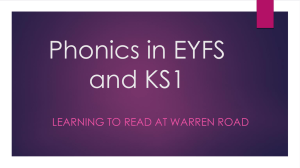Notes from Year R Phonics Meeting
advertisement
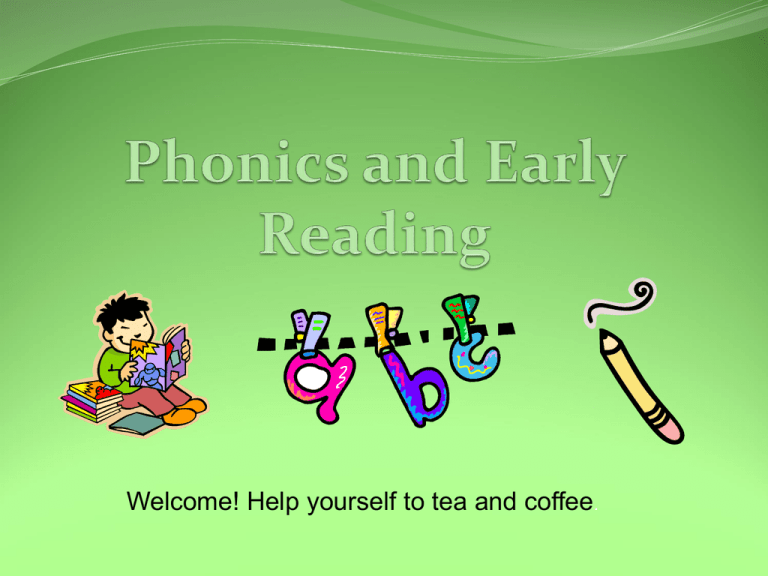
Welcome! Help yourself to tea and coffee. Workshop Outline Lifelong Readers How we teach reading at Kings Worthy Introduction to Phonics Approaches to Phonics Ideas to support reading at home Questions Lifelong Readers Nurturing a love of reading Reading isn’t a race – don’t panic! Reading for pleasure Reading for meaning How We Teach Reading Daily Phonics – focus on decoding Groups Letter recognition The Rose Report Sound blending - 2006 Whole word recognition Shared Reading Whole class or in groups Aspects of reading – holding the book, text direction, title, blurb Focus on comprehension skills and reading for pleasure Guided Reading Weekly from after half term, in small groups (approx. 6) Taught comprehension focus e.g. describing characters Applying phonic skills Individual Reading For assessment What is Phonics? What is phonics – Method for teaching reading and writing based on smallest units of sound in words Based on Letters and Sounds government document Taught daily in groups at the level each child is working at English Language The English language is made up of: 44 phonemes (sounds), Represented by 26 letters, In about 140 combinations. Key principles Sounds (phonemes) are represented by letters (graphemes) Focus is on letter sound at first, names later. A phoneme can be represented by one letter (grapheme) or by a group of 2 or more letters. e.g. sh, igh, ea. The same sound (phoneme) can be spelt in more than one way. e.g. cat, kennel, choir, sack The same grapheme (spelling) may represent more than one phoneme Mean – deaf Crown – flown Field – tie Identify the phonemes! pet born shed care night Skills used in phonics Blending for reading Merging phonemes together to pronounce a word. In order to read an unfamiliar word, a child must link a phoneme to each letter or letter group in a word and then merge them together to say the word. sh – o – p t – ai – l Segmentation for spelling Hearing individual phonemes within a word. E.g. crash has 4 phonemes c – r – a – sh In order to spell a word a child must segment a word into the individual phonemes and choose a letter or letter combination to represent the phonemes. For example a child may write: ‘The cat was blak. It had a wight tail and a pinc noas.’ Approaches The importance of speaking and hearing sounds in the early stages Songs, nursery rhymes, games Ruth Miskin Read Write Inc. Cued articulation Rhyme Alliteration Segmenting and blending “Robot Arms” Cursive handwriting Reading- setting the scene The colour band system The starting point: reading from pictures Ensure you are both relaxed and it is enjoyable, not a chore (for either yourself or your child!) It should always be a successful experience! Choose a suitable environment – quiet and comfortable, no tv! Please write in your child’s planner when they have read and a brief comment on how they got on. Reading- Strategies Book orientation- ‘Debugging’ the book, Look through for tricky words and names, discuss pictures. Write out any tricky words and learn them prior to reading. Get the children to build words with magnetic letters. Phoneme spotting – can you spot a ‘s’? Encourage children to look at the pictures to help support their reading- don’t cover them up! Decoding: Sounding out the words and blending them together. Reading around a difficult word and trying to work it out. Recognition of high frequency and tricky words Reading for meaning We choose books with the children twice a week, we talk to them about their choices and look at any follow up they may have done. Encourage children to re-read sentences if they’ve misread words OR if they’ve had to decode words which interrupt the fluency Don’t be afraid to demonstrate, then ask them to copy! Comprehension questions- check the back of the books. Look at the comprehension activities in the front of your planner for ideas, children can draw/write a response, stick in photos or you can write it for them. Keywords Keywords (or tricky words) – can’t be sounded out, e.g. the, to, all 45 Reception key words Keyrings The importance of discussion Questions to ask your child • Who is your favourite character in the story and why? • Which words in this sentence can you recognise without sounding out? • Which sounds can you see in this word? • What does the picture tell you about what is happening in the story? • What happened at the beginning of the story? What happened at the end? • Did you enjoy this story? Why? • What do you think will happen next? • Does the word you have sounded out make sense if you read the whole sentence again? • How many words are in this sentence? Can you point at each of them? • Can you point to where we need to start reading? • Which is your favourite page of this book and why? Key Messages Always use pure sounds when sounding out – as demonstrated Reading and spelling skills go hand in hand Use of letter names when spelling words and letter sounds for sounding out words E.g to spell sock would be S O C K but to sound it out would be only 3 sounds s-o-ck When reading, encourage children to segment new words, then blend together When spelling, encourage children to segment words they want to spell into the smallest chunks possible eg c-l-o-ck, rather than cl-ock. Then blend together to check they have got it right Use robot arms, sound buttons and phoneme frames when practising reading and spelling Enjoy it! Resources to take away Cued articulation action sheet Oral blending and segmenting activity ideas Ruth Miskin Sound Cards School handwriting policy Terminology sheet Question sheet to encourage discussion about your child’s reading book Reception 45 keywords Year One and Two keywords Questions
